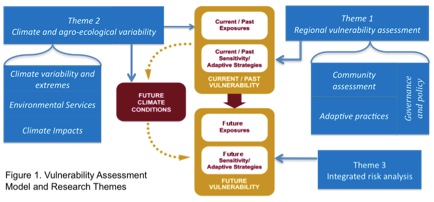The research design and conceptual framework follow a vulnerability assessment model and its associated community-oriented, participatory methodologies. This model is shown in brown in Figure 1 (with the project Research Themes - discussed below – in blue. Vulnerability is understood as the degree to which a system, such as a rural community or agricultural producer, is susceptible to the adverse effects of stressors and change. Vulnerability to climate change is a function of (1) exposure to climate hazards and their impacts; and (2) social conditions that determine sensitivity - the degree to which a system is affected by climate-related stimuli - and adaptive capacity, the ability of a system to adjust to climate risks and opportunities by increasing its coping range. The adaptive capacity of communities and producers depends on their access to a variety ofresources (economic, social, and natural), the availability of institutional resources provided by governance and policies, the management of current and past stresses, and the ability of institutions and individuals to learn from experience and to anticipate and plan for future change.

This vulnerability model, characterized as a “bottom-up” approach, offers a consistent framework for interdisciplinary and comparative research employing various methodologies, incorporating climate science, integrating structural institutional conditions and agency, and actively engaging stakeholders and decision makers. It directs all research activities towards evaluating past, current and future exposure, sensitivity and adaptive capacity, and applying knowledge of these determinants of vulnerability towards designing effective adaptation strategies. A version of this vulnerability framework was successfully applied to a recent five-year multi-collaborative study of institutional adaptation to climate change (IACC) in northern Chile and western Canada. The project revealed the central role of public institutions in developing adaptive capacity to climate change, but it also demonstrated and identified significant gaps in knowledge and government practice that lead to a deficit in adaptive capacity. Among the final recommendations from this major study of adaptation were:
• develop long-term (10-20 year) climate and water plans that build resilience to climate change
• integrate government and community adaptation activities
• focus efforts on improving local and regional coping capacities
• obtain and share more and better water data
• improve the dialogue between government and communities, particularly rural communities, to build local resilience and seek new opportunities, and
• seek solutions with interdisciplinary teams using social and physical sciences approaches and coordinating with stakeholders and policy makers
VACEA provides the opportunity to build on the results this previous project and reduce the existing adaptive capacity deficit by working with communities, and government institutions, in five countries. The VACEA project also represents an important departure from the IACC project and most other previous studies of adaptation, which typically have considered the impacts of changes in average conditions (e.g., temperature and precipitation), whereas we now propose to focus on climate extremes and variability, that is, the departures from mean conditions, whether natural (internal) variability or the consequences of global warming. The proposed approach and design of the VACEA project therefore addresses gaps in knowledge and practice recognized by the research team from other studies of regional vulnerability and adaptation.
